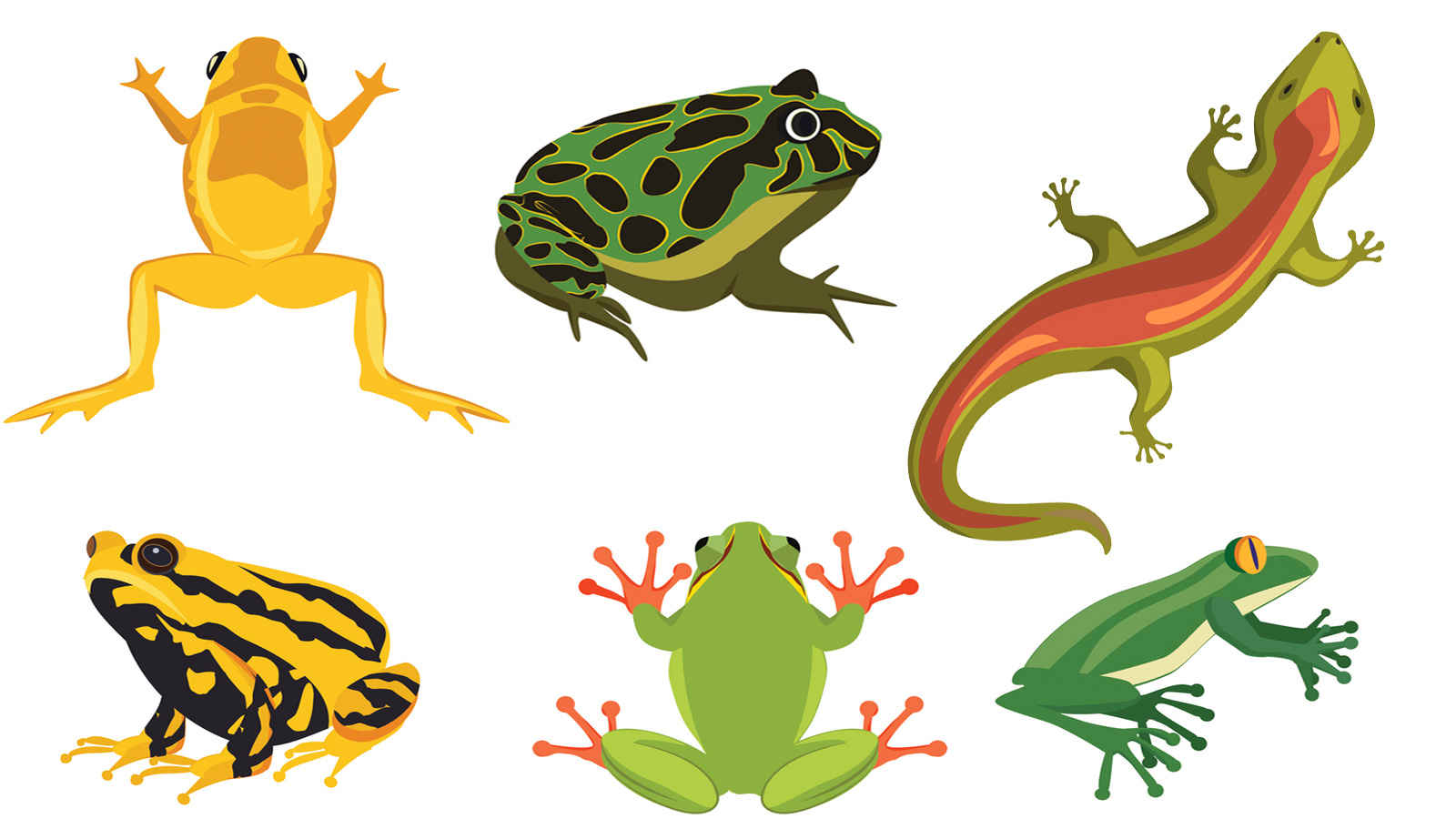Are Amphibians Ectothermic Or Endothermic
Basic Types of Animals and Their Characteristics
Scientists sort the dissimilar types of animals in the earth into categories based on certain characteristics. Animals are generally grouped into half dozen types of animals. The system for animal classifications is called taxonomy.
 illustrations of vi unlike types of animals
illustrations of vi unlike types of animals
The Animal Kingdom
All animals vest to a biological kingdom called kingdom Animalia. This kingdom is then broken downwardly into over 30 groups, or phyla (plural form of phylum). Almost 75% of all species on Earth are animals. Animals are and so cleaved down into two types: vertebrates and invertebrates.
- Animals with a backbone are vertebrates.
- Vertebrates vest to the phylum called Phylum Chordata.
- Vertebrates are further broken downward into five classes: amphibians, birds, fish, mammals, and reptiles.
- Animals without a backbone are invertebrates.
- Most invertebrates are in the phylum Arthropoda.
All Almost Amphibians
All amphibians are vertebrates, and they need moist environments or h2o to survive.
- They are cold-blooded.
- They absorb h2o and breathe through their thin skin.
- They have at least one special skin gland used for defense.
- Virtually follow the life bike of egg-larva-adult.
Examples of Amphibians
You tin notice examples of amphibians all around the world. In some cases, examples of amphibians seem similar the aforementioned animals, just they can be quite different like a frog and a toad.
- frogs
- newts
- salamanders
- toads

All About Birds
Birds are a type of warm-blooded vertebrate that are adapted to fly.
- Not all birds can fly, but they practise all have wings.
- Birds have beaks that help them catch and eat food.
- The digestive system of a bird allows it to consume whenever it tin can and digest the food later.
- Birds lay eggs to reproduce.
- They are endothermic, meaning they maintain their ain constant torso temperature.
- They are bipedal, which means they have 2 legs.
- They accept hollow bones and their bodies are covered in feathers.
- Birds belong to the class called Aves.
Examples of Birds
Birds are some of the most recognizable animals, and you probably see unlike types of birds every day.
- albatrosses
- chickens
- hummingbirds
- falcons
- flamingoes
- ostriches
- owls
- parrots
- penguins
- pigeons

All About Fish
Fish are also vertebrates, and they are considered the oldest-known vertebrates.
- They are ectothermic, or common cold-blooded, which means they rely on their surroundings to regulate their torso temperature.
- Fish have fins.
- Most, merely not all, fish have bodies covered in scales and exhale through gills.
- Fish live underwater.
Examples of Fish
There are over 30,000 species of fish alive today, more than all other vertebrate groups combined.
- eels
- hagfish
- lampreys
- minnows
- rays
- salmon
- seahorses
- sharks

All Near Mammals
Mammals are another type of vertebrate that belong to the class Mammalia.
- Young mammals get nourishment from milk produced by their mothers.
- Most mammals have pilus.
- Their jaw is hinged directly to their skull, unlike all other vertebrates.
- Almost all mammals give nascence to live babies.
- They are endothermic, or warm-blooded.
Examples of Mammals
There are over 5,500 living species of mammals all over the earth.
- aardvarks
- bats
- elephants
- hamsters
- humans
- rabbits
- rhinoceroses
- whales

All About Reptiles
Reptiles are thought to be the outset vertebrates to alive completely on land. Simply, not all reptiles live just on country today.
- They are cold-blooded, or ectothermic.
- They lay eggs to reproduce.
- They have four legs or are descended from animals with four legs.
- They breathe through lungs.
- Their bodies are covered in scales or scutes.
Example of Reptiles
Different species of reptiles tin be tiny or huge.
- crocodiles
- geckos
- lizards
- bounding main turtles
- snakes
- tortoises
- turtles

All About Invertebrates
Approximately 95% of all animals are invertebrates. Invertebrates do not have a backbone. At that place are different types of invertebrates, but they all share a few characteristics.
- They are fabricated up of many cells that work together or are multicellular.
- Most, but not all, have tissues, cells that work together in a more complex style.
- About, but non all, can motility.
- There are over 35 phyla of invertebrates.
- They by and large accept soft bodies.
Types of Invertebrates
There are eight phyla of invertebrates that are alive today.
- annelida - take a segmented torso and archaic brain
- arthropoda - have jointed appendages and an exoskeleton
- cnidaria - have tissues and an incomplete digestive system
- echinodermata - have some type of spiny structure on their outside
- mollusca - generally have soft bodies and a difficult exoskeleton
- nematoda - unsegmented with worm-shaped bodies
- platyhelminthes - soft, ribbon-like worms with no respiratory system
- porifera - multicellular organisms living in water with no organs or tissues
Examples of Invertebrates
Most invertebrates are insects, simply there are over i million species of invertebrates in the world.
- anemone (cnidaria)
- clams (mollusca)
- coral (cnidaria)
- venereal (arthropoda)
- earthworms (annelida)
- flatworms (platyhelminthes)
- insects (arthropoda)
- jellyfish (cnidaria)
- leeches (annelida)
- roundworms (nematoda)
- sea urchins (echinodermata)
- snails (mollusca)
- spiders (arthropoda)
- sponges (porifera)
- squid (mollusca)
- starfish (echinodermata)
- tapeworms (platyhelminthes)

Are Amphibians Ectothermic Or Endothermic,
Source: https://examples.yourdictionary.com/basic-types-of-animals-and-their-characteristics.html
Posted by: rileywithery.blogspot.com


0 Response to "Are Amphibians Ectothermic Or Endothermic"
Post a Comment